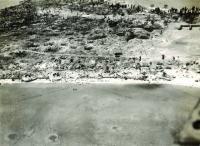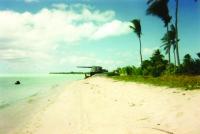Written By: Honorable George A. Jones

War hero Edward Heimberger, future actor Eddie Albert.

Tarawa aerial view 24 Nov 1943

Julian C. Smith, USMC

8-inch Japanese gun Betio

The tractor on the log wall was hit while attempting to carry its load of Marines up on the island.

Prisoners huddle on the end of pier as shore party personnel manhandle supplies of water.
“They sought to prevent our troops from disembarking. Disembarkation was a matter of extreme danger for the following reasons. The ships, on account of their size, could not be run ashore except in deep water; the troops, though they did not know the ground, had not their hands free and were loaded with great and grievous weight of their arms had nevertheless at the same time to leap down from their vessels, to stand firm in the waves and to fight the enemy.”
The above is not the after action report of the battle of Tarawa. It is Julius Caesar’s description of his invasion of the south coast of England in 54 B.C.
Tarawa is an atoll of twenty square miles, composed of sixteen small islands and is part of the Gilbert Islands, located in the Central Pacific. The largest of the sixteen islands is Betio, a flat piece of land no higher than ten feet above sea level and about the size of New York City’s Central Park. It is two miles long and seven hundred yards at its widest. It was surrounded by coral reefs and subject to the tides of the ocean.
On 20 Nov., 1943, Task Force 53, composed of battleships, aircraft carriers and transports carrying the 2nd Marine Division, arrived off the coast of little Betio. This was part of Operation Galvanic initiated by Admiral Chester W. Nimitz during the summer of 1943.
Earl Ellis, a young Marine officer, studied amphibious assaults. He realized that these assaults could be used to seize strategic islands which would then allow the U.S. Navy to advance through the Central Pacific and execute Plan Orange. A meeting with General John Lejune, who would later be Commandant of the U.S.M.C., led to a strong relationship with Ellis and the adoption, by General Lejune, of Ellis’s amphibious warfare doctrine. The U.S. Army paid little attention to amphibious warfare. Attaching the U.S.M.C.’s raison d’etre to the Navy’s Plan Orange insured the survival of the U.S.M.C.
For over a decade the plan sat on the shelf and now the 2nd Marine Division was sitting off Betio Island ready to put the plan to the iron test of experience. The Japanese seized Tarawa on 9 Dec. 1941 without any opposition from British forces. The next one and a half years were spent converting this pancake island into one of the most formidable fortresses in the Pacific theater.
Rear Admiral Tommori Saichiro’s forces constructed block houses, machine gun nests, pill boxes, and other obstructions. Emplaced tanks and artillery emplacement bristled throughout the island. These defenses’ purpose was to protect the air field located in the center of Betio. Rear Admiral Keyi Shibasaki assumed command of 2669 Imperial Marines from R.A. Saichiro. He was a graduate of the Imperial Japanese Naval Academy in 1915 in the top 1/3 of his class. He served on several warships and was a veteran of amphibious operations in China during the 1930’s. He now sat in a command blockhouse surrounded by defenses upon which he had remarked that, “a million men cannot take Tarawa in 100 years.”
Waiting off Betio was TF 53 under the command of Rear Admiral Harry Hall aboard the Battleship Maryland. Lt. Col. David M. Shoup, S3 of the 2nd Marine Division, planned the amphibious assault of Betio. Lt. Col. Shoup was born 30 Dec. 1904 in Battle Ground, Indiana. He attended DePauw University and due to financial difficulties enrolled in the R.O.T.C. After graduation in 1926, he was commissioned in the U.S.M.C. His military career consisted of service on various ships and U.S.M.C. camps and in China. Most of his service dealt with staff and teaching duties.
As TF 53 sat off Betio, Col. William Marshall, the original commander of the massive assault forces, suffered a heart attack and his command fell to Lt. Col. Shoup. In the early morning hours of D-Day, Marines climbed down into Amtracs. From the beginning, Col. Shoup’s time schedule began to go awry. H.-hour was 8:30 am, but due to the normal friction of war the time was pushed up. To this was added delay due to absent naval and aircraft attacks and strong currents in the lagoon.
Three waves of Amtracs, followed by two waves of LCVP’s, Higgins boats, sped toward the reef. The first wave met heavy Japanese fire when it reached the reef. Death, confusion, and chaos took command. Units became disorganized and missed their assigned landing zones and became mixed with each other. Within fifteen minutes 1,500 Marines had landed on the three red beaches and green beach. Due to the dearth of Amtracs, Higgins boats were utilized to bring in the remainder of the assault forces. Higgins boats, being bigger than Amtracs, required four feet of water to cross the reef. On D-Day a neap tide prevented the Higgins boats from reaching the beach. This problem would last for thirty hours.
A major crisis ensued. The Marines stuck on the reef either had to wait for the Amtracs to return from the beach and transport them or start wading 100 yards in the sea to the beach. Either action took place as Japanese artillery, tanks, MG and rifle fire inflicted death and wounds to the invading Marines. One Marine stated, “The water was red and it takes a lot of blood to make water red.”
In addition to the new Amtracs, fourteen Sherman tanks with a few Stewarts were attached to the 2nd Marine Division. Most fared no better than the struggling infantry. Several tanks were sunk in their transport and those which made it to the reef fell into holes as they tried to make their way to the beach. Those that reached the island were thrown into battle without any coherent battle doctrine. Tank-to-tank battles occurred and the tanks began to fight successfully with the infantry, slowly and painfully developing a combined arms doctrine.
Once Lt. Col. Shoup entered the battle, after some delay, a semblance of order began to emerge. Individual actions from private to colonel began to stabilize a very dangerous situation. 5,000 Marines had assaulted the beach on D-Day. By midnight 1,500 were dead or wounded. Would the night bring a dreaded banzai attack and push the Marines into the sea? The worst did not materialize. Unknown to the Marines, the god of war descended from the heavens in the form of a naval gun barrage upon a group of Japanese officers moving from their command center to another blockhouse. Once the dust dispersed, this group of officers lay in pieces. Rear Admiral Shibasaki died with his staff. The decapitation of Japanese command and control left the remaining Japanese forces without a unified command and thus no banzai attack was ordered on the critical night of the invasion when the Marines were their most vulnerable.
The second day dawned just as dangerous as D-Day. Hundreds of Marines were killed and scores of landing craft were destroyed as they hit the reef. The status quo was not broken until Major Mike Ryan organized Marines from many mixed units into a formidable fighting force. With the aid of two tanks and naval gunfire this force was able to fight its way down the west coast of the island and thus expanding a toe hold to a size sufficient to allow more reinforcements to be landed.
On the other beaches, Marine officers like Major William Chamberlain by their courage and leadership led their men in attacks on Japanese troops and strong points. “Follow Me!” was the operative command. Japanese forces were split and destroyed in detail.
Col. Sharp spent the second day organizing and directing the increasing number of marines and equipment. His valiant efforts resulted in him being awarded the Medal of Honor.
The Marines developed a tactic of blind, blast, and burn. Rifle fire to blind, TNT satchel charges to blast, and flame throwers to burn. The crisis was over. The Japanese conducted an uncoordinated counterattack that was destroyed. Finally, Col. Shoup was able to report to General Julian Smith that, “We are winning!” As night fell on the 2nd day, Col. Shoup, exhausted and wounded, was relieved by Col. Merritt A. “Red Mike” Edsen.
During the carnage of the 2nd day, a Naval Reserve Officer in command of a Navy salvage boat was sent to the invasion lanes to salvage broken and wrecked boats. As he approached the reef, he saw, among the floating dead, many sick and wounded Marines. He made many trips transporting these causalities. On one of his trips he spied a group of unarmed Marines and offered to evacuate them. They informed him to take the wounded and return to them with rifles. When he returned all he found were dead Marines. This Naval officer spent the remainder of his time saving stranded and or wounded marines. This officer is Edward Heimberger who most of us knew as Eddie Albert, movie and TV star of the movie “Brother Rat” and the TV comedy, “Green Acres.”
The 3rd day was spent exploiting the gains of the second day with more offensive actions. Japanese pockets of resistance were destroyed. Disjointed Japanese attacks were met with devastating fire. As a result, more and more of Betio came under control of the Marines. Due to the Japanese doctrine of no surrender, the Marines had nothing left to do but kill every Japanese soldier and marine who would not give up. Only 17 Japanese troops and 129 Korean laborers were captured. 1077 Marines and 29 U.S. Navy sailors, mainly corpsmen, died and 2292 Americans were wounded.
Much controversy surrounded the Battle of Tarawa. Some, even a Marine officer, viewed the Battle of Tarawa as a waste of lives and had no worthy purpose. The American dead were shown to the American public for the first time and it shocked them. I think that this criticism is short-sighted. One must remember that Tarawa was the first amphibious assault conducted in the Pacific Theater. There would be many more such assaults.
Many lessons were learned by fighting this 76-hour battle. The primary lesson was that a commanding general is only as good as his maps or his knowledge of geography of the battlefield. Geography is much more than the configuration of the dry land, as we have seen with the underwater topography of Betio; i.e. the reefs were crucial. Also the intangible forces of wind and surf and tide can break an army before it can ever reach dry land. Man’s modification of the natural geography is also of vital importance. Sea walls, mines, underwater and land-based obstacles, man-made ditches and reinforced strong points all must be discovered and prepared to be met.
All these lessons were learned on Tarawa and applied to all amphibious assaults until the end of WWII in the Pacific, resulting in Victory at Sea for The United States of America. A military historian said, “Geography is the Rosetta Stone of Battles.” A failure to discover the secrets of the geography brought much death and destruction to the U.S. Marines on Tarawa.
«Go back to the previous page.





